Diamond Industry Trade And Engagement Ring Statistics

Whether you are someone who is searching for statistics to perform an analysis of the diamond market or looking for the latest diamond market trends to buy an engagement ring, you’ve come to the right place.
Here is an overview of the data and statistics you can find in this write up:
Diamond Market Industry & Mining Statistics
– Global diamond jewelry market value.
– Breakdown of diamond jewelry consumption by country.
– Production volume: How much diamonds are mined each year?
– Rough diamond production volume by country.
– Rough diamond production value by country.
– Countries with the largest diamond reserves.
Diamond Engagement Ring Buying Statistics And Survey Results
– What is the average spend on an engagement ring?
– What is the average carat size of a diamond engagement ring?
– Which is the most popular diamond shape?
– What are the most important factors when buying a diamond ring?
– What is the most popular diamond color rating?
– What is the most popular diamond clarity rating?
– Top 3 most popular ring styles among millennials & Gen Z?
Blood Diamonds Statistics And Facts
– Where are blood diamonds found?
– How many people died from blood diamonds?
Lab Created Diamonds Statistics And Facts
– Interest and popularity of lab created diamonds.
– The trend of CVD diamond production costs in USD.
– Lab grown diamond vs natural diamond price comparison.
– Lab grown diamond market share and future estimate.
Diamond Market Industry & Mining Statistics
The diamond industry has always been one that is driven by the economic climate and changing trends in consumer behavior. In this section, we take a look at some statistics of the global diamond market and trends that had been happening in recent years.
Global Diamond Jewelry Market Value
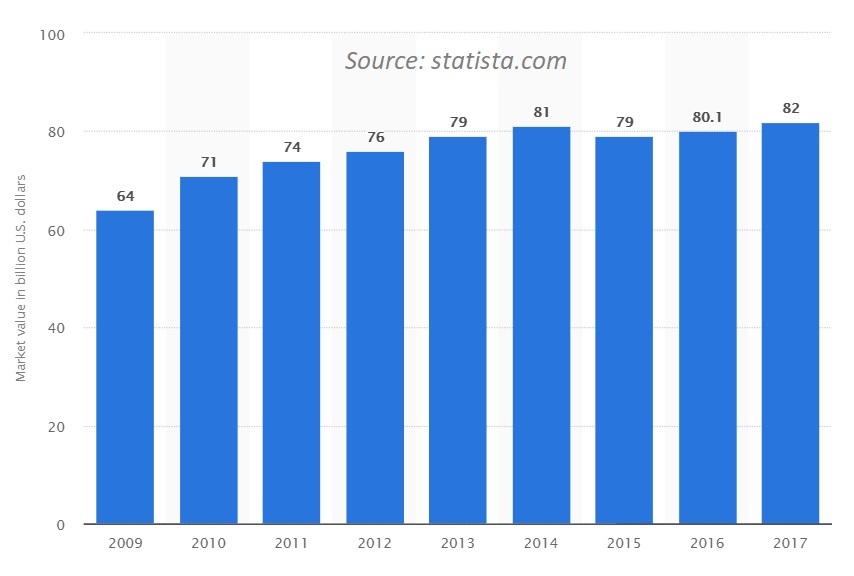
Since the global financial crisis in 2009, the global diamond jewelry market has grown from 64 billion U.S. dollars to 81 billion U.S. dollars in 2014. However, the global market value for diamonds has since been relatively flat and amounted to 82 billion U.S. dollars in 2017 due to a glut in polished diamond inventory.
Breakdown of Diamond Jewelry Consumption by Country

The United States accounts for more than 50% of global diamond jewelry demand and has seen healthy growth rates year-over-year. China is in second place and makes up about 12.2% of global demand. They are projected to become one of the biggest consumers of diamond jewelry with a fast growing middle-income population.
Production Volume: How Much Diamonds Are Mined Each Year?
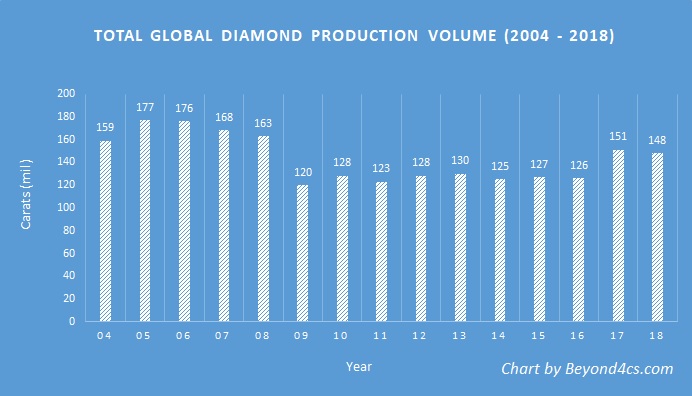
Raw data source: Kimberley Process Certification Scheme
Peak diamond production occurred between 2005 to 2007 where miners produced close to 170 carats per year. The financial crisis of 2009 caused a worldwide recession and demand for diamond jewelry plummeted.
Since then, the global volume of diamonds mined has largely been stagnant before mining activity picked up again in 2017 where production increased by nearly 20%.
Rough Diamond Production Volume by Country
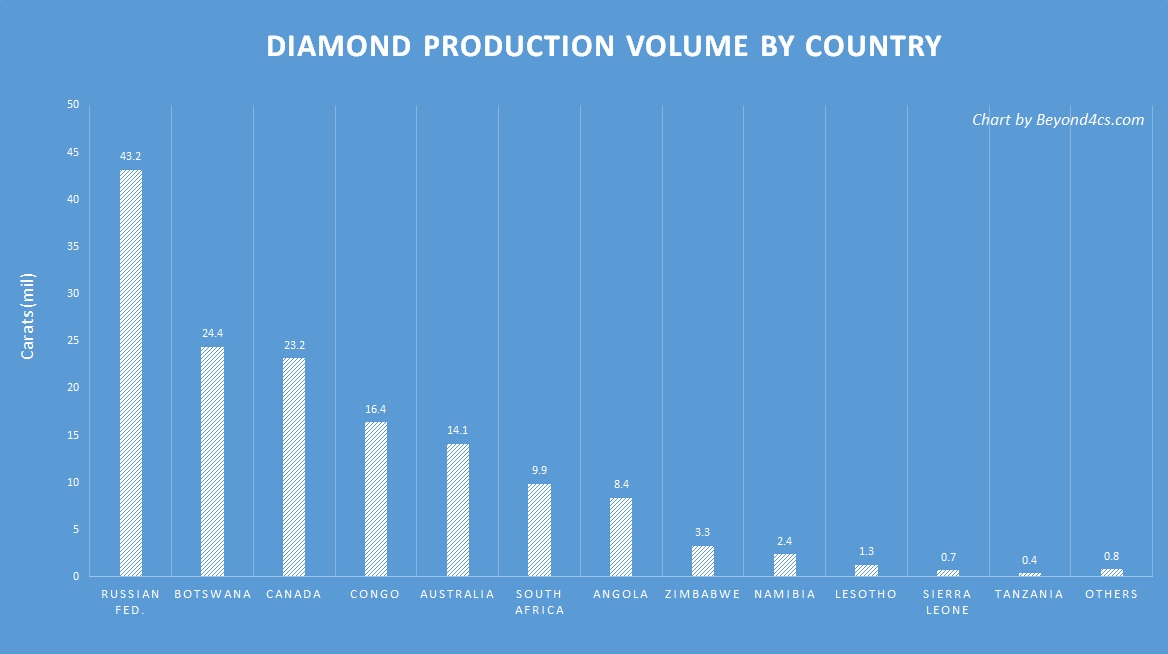
Raw data source: Kimberley Process Certification Scheme
Russia is by far the world’s largest producer of diamonds with an output of 43.2 million carats. Combined together, the top 5 producing countries (Russia, Bostwana, Canada, Congo and Australia) account for more than 80% of the global supply of rough diamonds.
Rough Diamond Production Value by Country
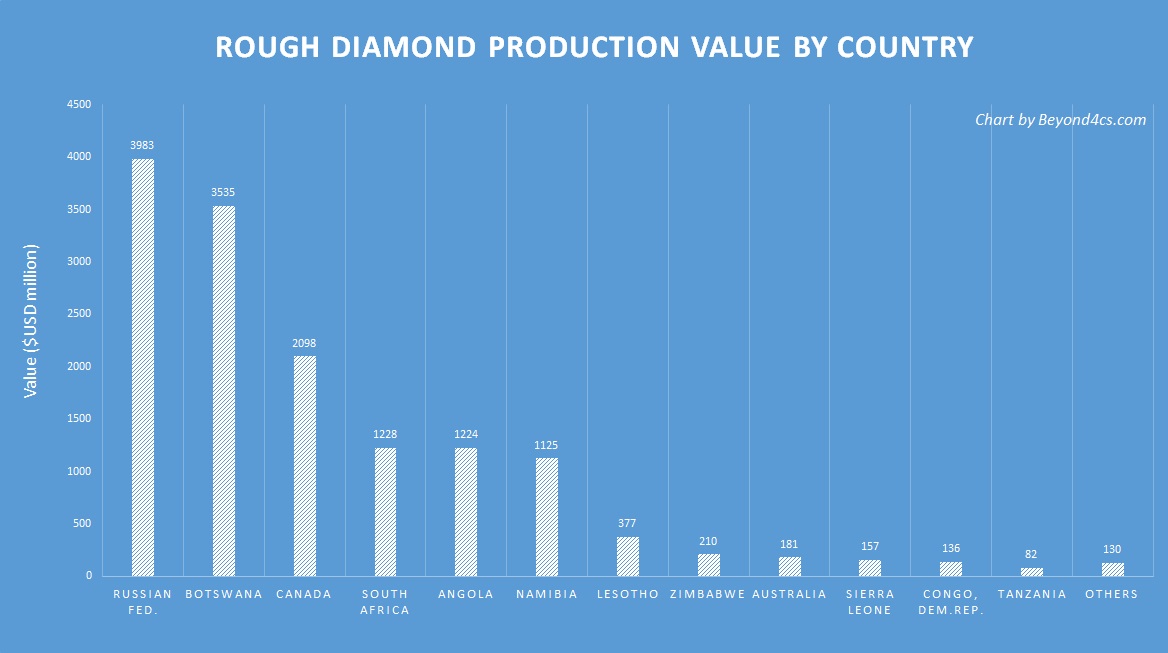
Raw data source: Kimberley Process Certification Scheme
Russia is the world’s largest producer of rough diamonds by volume and it comes as no surprise that the total value of their production is also the highest in the world (3983 million USD). In a relative comparison, Bostwana’s production in terms of dollar value is almost that of Russia’s even though it produces a lot less rough diamonds by volume.
This is because the bulk of Russia’s rough diamonds are industrial grade whereas those of Bostwana’s are gem quality and command a high price per carat. To put simply, Russia produces a lot of low quality rough diamonds that are worth less in market value.
Countries With the Largest Diamond Reserves
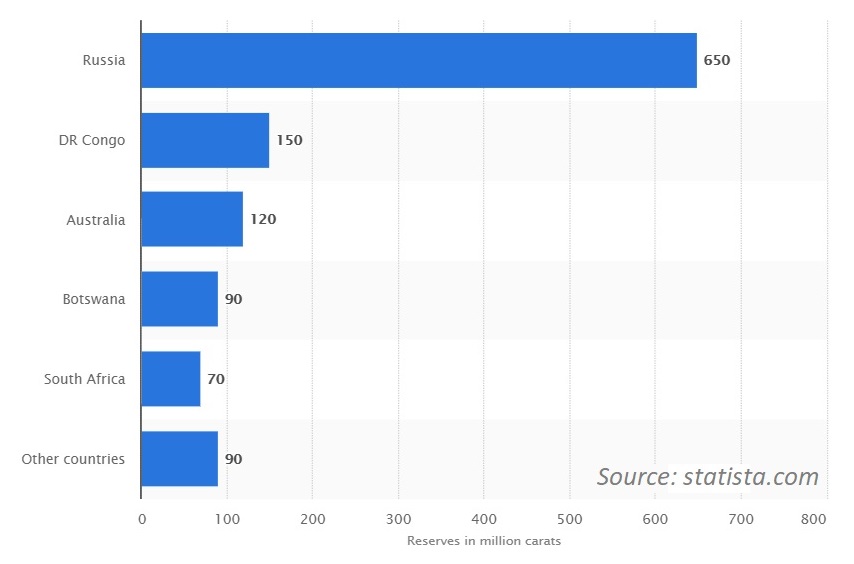
The largest diamond reserves in the world are found in Russia and the continent of Africa. If you are wondering how much diamonds there are left in the world, the answer is a staggering total of 1170 million carats. Here, I would like to point out that as exploration and new discoveries of diamond deposits are found, this number would likely increase in the future.
Diamond Engagement Ring Buying Statistics And Survey Results
In this section, the data compiled here are based on a consumer study performed by Beyond4cs.com and other sources like De Beers. Hopefully, this can help you gain some insights into what people are buying and help you make better purchase decisions.
What is the Average Spend on an Engagement Ring?
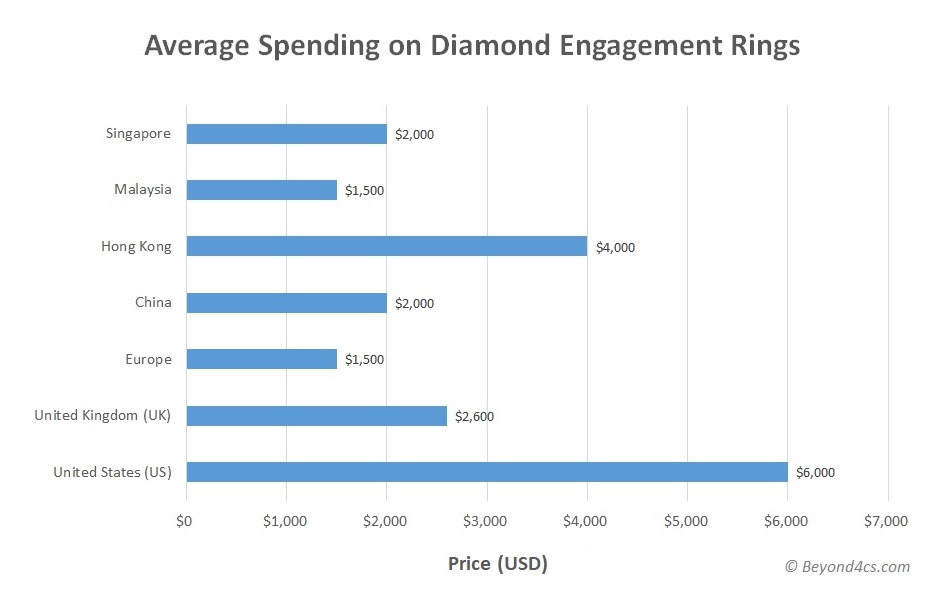
In a study performed by Beyond4cs.com, the average spend on an engagement ring in the US is $6000. On a global scale, US consumers are the biggest spenders on diamond engagement rings followed by Hong Kong. Interestingly, it was also found that most men were willing to spend more on an engagement ring than a woman would expect them to.
What is the Average Carat Size of a Diamond Engagement Ring?
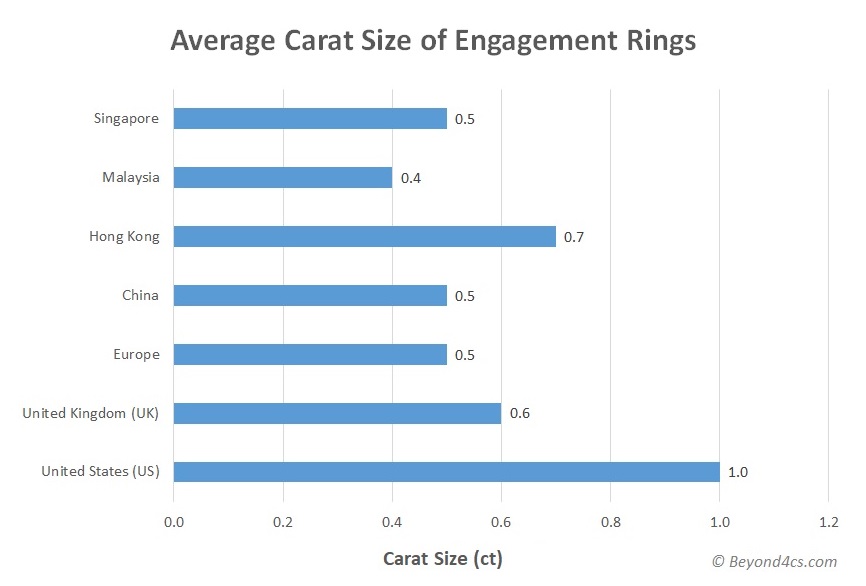
The average carat size of a diamond engagement ring in the US is 1 carat and American consumers have the biggest average diamond size in the world. In comparison, consumers in other first-world economies typically buy a diamond ring that’s roughly half a carat in size on the average.
Which is the Most Popular Diamond Shape For an Engagement Ring?
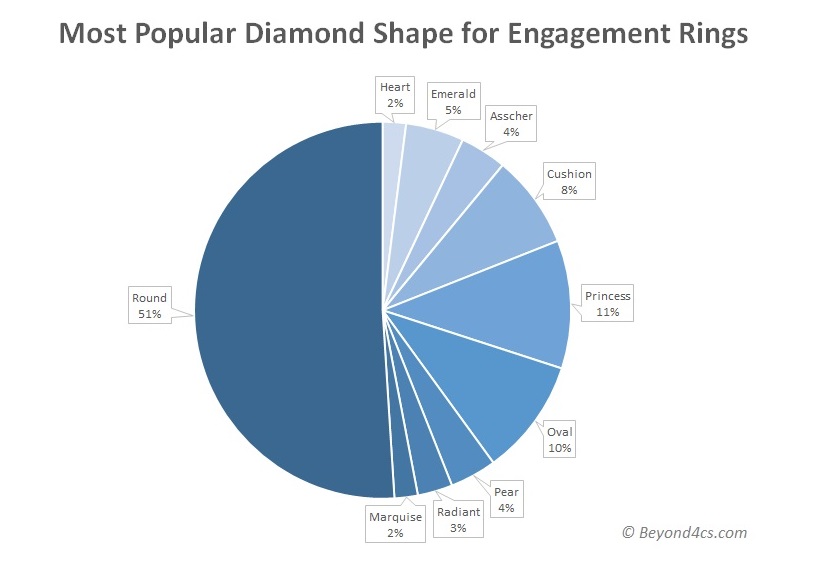
The round cut diamond is by far the most popular diamond shape for engagement rings and accounts for roughly 50% of diamonds sold in the USA. The next most popular shapes are the princess cut and oval cut. Now, I do want to point out that this is a net aggregate opinion of consumers in the United States as they are the largest market for diamond jewelry.
The choice of shape may vary with different country and culture. For example, in China, round diamonds account for 40% of all diamonds sold. However, the second most popular shape is the heart cut diamond which accounts for 20% of diamond engagement rings sold locally.
What Are The Most Important Factors When Buying a Diamond Ring?

The 2 most important things that women care about in a diamond engagement ring is ring design and carat size. So, if you are shopping for a diamond ring for someone, make sure you find out what their style preferences and their expectations of the diamond ring are.
On the other hand, the two most important factors for guys are cost and ring design. As most guys are the ones who are paying for the diamond engagement ring, their budget is one of the key things that affect how they make decisions.
What is the Most Popular Diamond Color Rating?
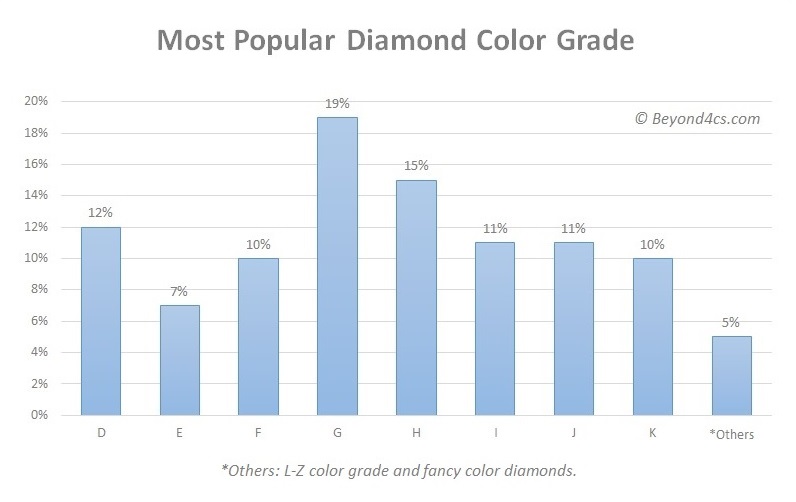
Near colorless diamonds (G to J) represent the bulk of the diamonds purchased for engagement rings. From the statistics above, we can clearly see that G color is the most popular rating that people are buying.
It is also interesting to note that 12% of consumers choose to buy D color diamonds (best grade) for their engagement rings because of symbolic reasons.
What is the Most Popular Diamond Clarity Rating?

When it comes to diamond clarity, VS2 and SI1 diamonds are the most popular choice for engagement rings. Flawless and Internally Flawless diamonds account for 1 in 10 of engagement rings that people are buying.
We also see an interesting 10% of consumers who buy I1-I3 diamonds even though they are perceived as low quality and have eye visible inclusions. People who have been surveyed to buying I1-I3 clarity diamonds typically bought them from large jewelry chain stores and local stores.
Top 3 Most Popular Ring Styles Among Millenials & Gen Z
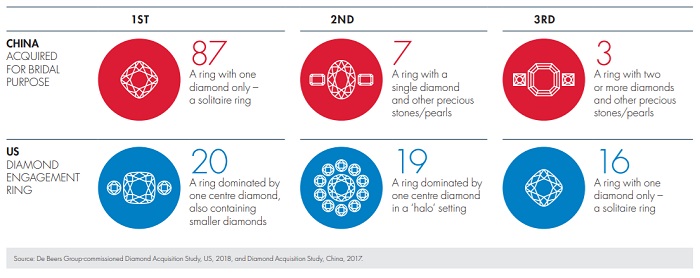
Diamond rings are very popular as proposal rings and bridal jewelry. In China, the most popular type of ring setting is the solitaire design and there is a preference for platinum over white gold. On the other hand, consumers in the US have a preference for diamonds with sidestones or halo designs and white gold is the preferred metal for diamond jewelry.
Blood Diamonds Statistics And Facts
Blood diamonds (also known as conflict diamonds, war diamonds, hot diamonds, or red diamonds) are rough diamonds that are mined in war-torn countries and used to fund conflict activities.
Before the Kimberly Process was introduced in 2003, it is estimated that up to 25% of the world’s diamonds originated from illegal trading activities and nearly 20% of these diamonds were conflict in nature.
Today, the wars have ended and there aren’t any blood diamonds that are mined to fuel conflicts. However, there is still an estimated of less than 0.2% of diamonds that are illegally traded.
Where Are Blood Diamonds Found?
A majority of blood diamonds are found in Angola, Sierra Leone, and Congo. These 3 countries are filled with natural resources, yet remain the poorest countries because of civil wars and corrupt governments.
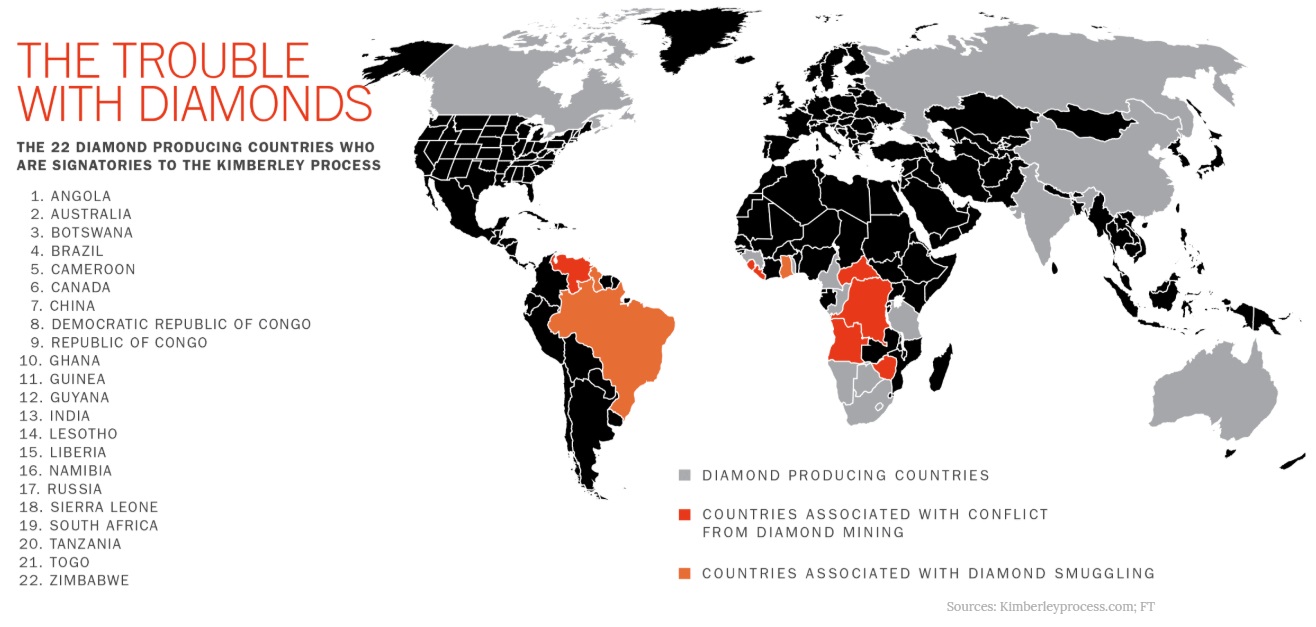
How Many People Died From Blood Diamonds?
It’s estimated that between 3.5 to 4 million people lost their lives due to blood diamonds. The highest number of casualties originated from the Democratic Republic of Congo where an estimated 3 million people died.
Besides the high death toll, there are many more millions of people who are still dealing with the consequences of these wars. Although the wars have ended, victims still bear physical and emotional scars that they will carry for the rest of their lives.
Lab Created Diamonds Statistics And Facts
Lab created diamonds have similar physical and chemical properties as natural diamonds. Both are real diamonds with the differences being that one is created by forces deep within the Earth while the other is made in a laboratory.
On a commercial production scale, there are 2 methods that are used to create diamonds in the laboratories: HPHT (high pressure, high temperature) and CVD (chemical vapor deposition).
Roughly 98% of lab created diamonds (both industrial and jewelry applications) are created by HPHT. In contrast, only 2% of the total volume of synthetic diamonds are made using CVD. The reasons for the stark differences in volume boils down to price economics and production scale.
Interest And Popularity of Lab Created Diamonds
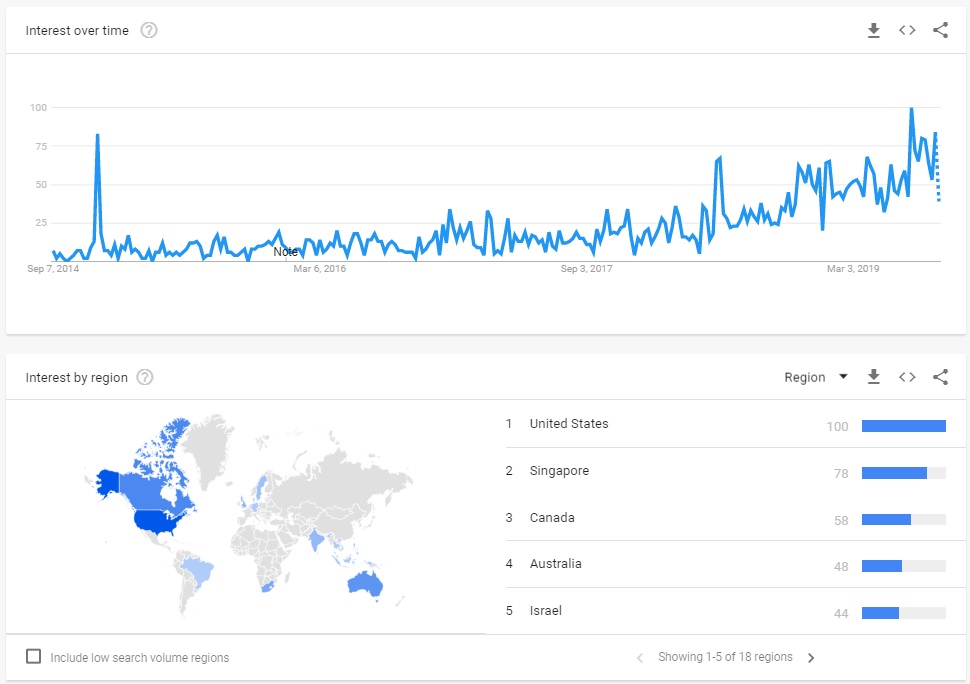
Interest in lab grown diamonds had grown tremendously over the past 5 years due to lower prices and better awareness. Google Trends reported a significant jump in search interest for synthetic diamonds since 2017.
The Downward Trend of CVD Diamond Production Costs in USD

Since 2008, the production costs for synthetic diamonds have decreased by 10-fold due to better equipment and cost control efficiency. As technology and manufacturing techniques improve, future reduction in costs is expected for making synthetic diamonds.
Lab Grown Diamond vs Natural Diamond Price Comparison

Retail prices for lab created diamonds had been drastically cheaper in 2018 than in 2016. At the time of writing, you could now buy a lab-created 1 carat G/VS diamond for less than half the price of an equivalent natural diamond.
Trend of Lab Grown Diamond Market Share

Over the years, the market share of lab grown diamonds has been steadily increasing. This can be attributed to the better cost-efficiency of mass production and better awareness of lab created diamonds.
By 2030, it is estimated that 9% of diamond jewelry sold on the global market will be of lab created origins.
References – Data Sources, References And Readings
Kimberly Process Rough Diamond Statistics – https://kimberleyprocessstatistics.org
Statista – https://www.statista.com/topics/1704/diamond-industry/
De Beers Group – The Diamond Insight Report 2018
Time Magazine – Blood Diamonds
Global Witness – Truth About Diamonds Report
Bain & Co – The Global Diamond Industry
Leave A Comment










12 Comments
Given how much diamond has been mined and the depleting resources we have in reserve, would you think the supply of diamonds would ever fall sharply and lead to a rise in prices? I’ve read that the Argyle mine is near its end of life and pink diamonds will soon be very rare because there will no longer be in production.
In general, the supply of diamonds will not fall because of lab created diamonds. Any demand can now be met with making more diamonds synthetically and that includes fancy colored diamonds. As for Argyle, you are right. It is going to close in a few years’ time and natural pink diamonds will have a very limited supply. As for prices, I can’t predict where it will go but if economics work, then it should go upwards if there is increased demand.
Do you know how much diamond has been mined since commercial activity has started in the 19th century? I’m doing a school research project on environmental impacts in relation to the number of carats that diamonds had been extracted from the Earth.
I don’t have the numbers or stats that date so far back to 19th century. I don’t think anybody would have a concise answer except for De Beers themselves as they were the most dominant mining company during that period of time.
Do you have any statistics or facts on the fancy color diamond industry value? Also, if you could provide some insights/percentages on how many sales is diamond in nature when people buy jewelry?
Sorry! I don’t have the stats or have a good estimate on the fancy color diamond industry worth. My work on Beyon4Cs.com is focused on white diamonds and I don’t have stats on retail sales breakdowns. Also, what is very important is how you define as jewelry. Does this include gemstone jewelry? Costume jewelry? Sterling silver jewelry etc? Diamond jewelry would be considered a higher tier luxury product.
Thanks for the article! I’m doing a research project for a high school assignment and was looking for blood diamond facts and statistics. Your data really helped! I’m also looking for conflict diamond statistics for the present day. Would you know how much of those diamonds are in circulation now?
Ever since the Kimberly process kicked in and was implemented by the different countries, there is less than 0.02% of conflict diamonds in the market now.
What percentage of diamonds come from Africa and how many blood diamonds are sold each year?
As at 2019, the percentage of diamond that comes from the continent of Africa is about 68 million carats and it is worth roughly $8.1 billion dollars. The 5 biggest African producers are Angola, Botswana, Congo, South Africa and Zimbabwe. Technically speaking, there are no more blood diamonds in the market as the wars had already ended many years ago.
I believe the blood diamond trade is on the still à major pre-occupation. Sierra Léone, Angola and DRC. Central African Republic should be added to the list because of rebels wars that there. Also in thèse countries, artisan exploitations are still on the rise, which is not documented in their countries but are transited across neighboring countries where they are purchase and given the necessary treatments per se.
Thank you for this valuable information.
This will assist with Marketing.